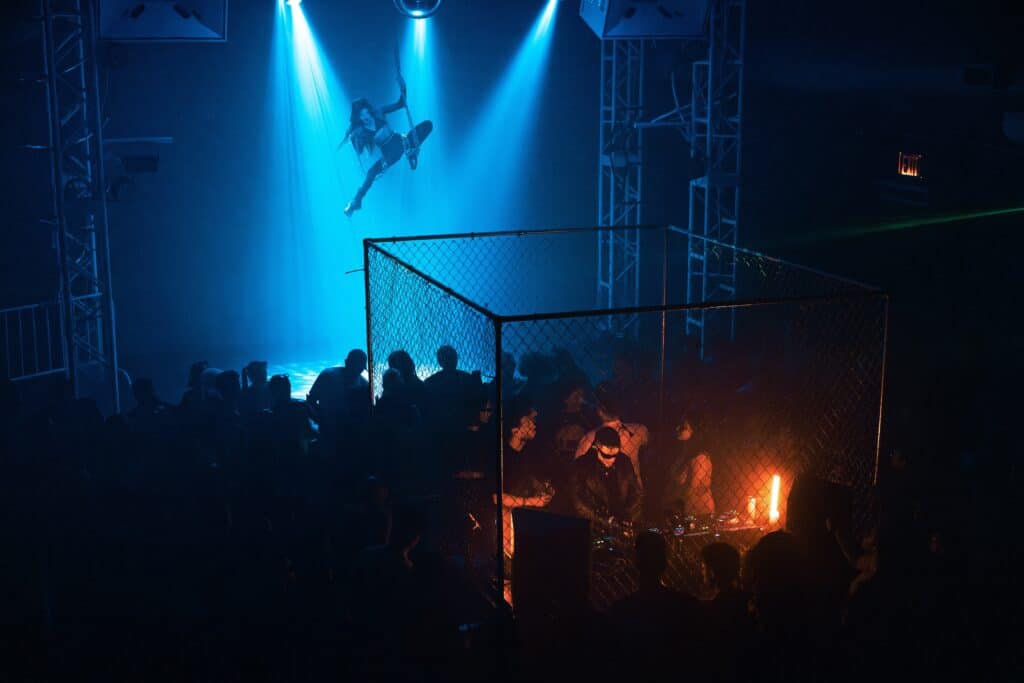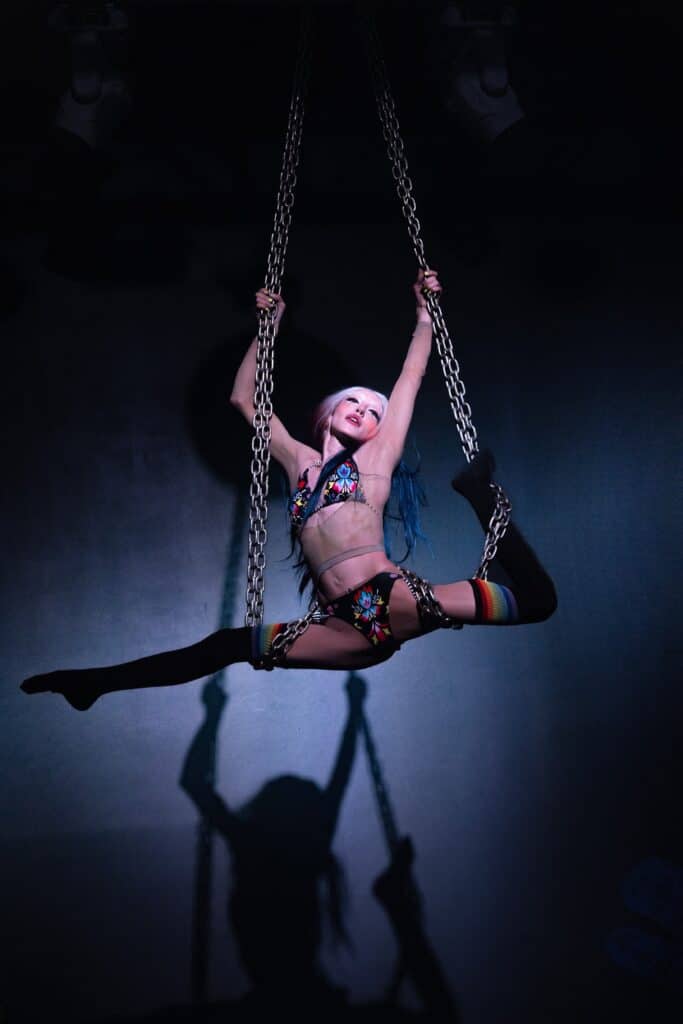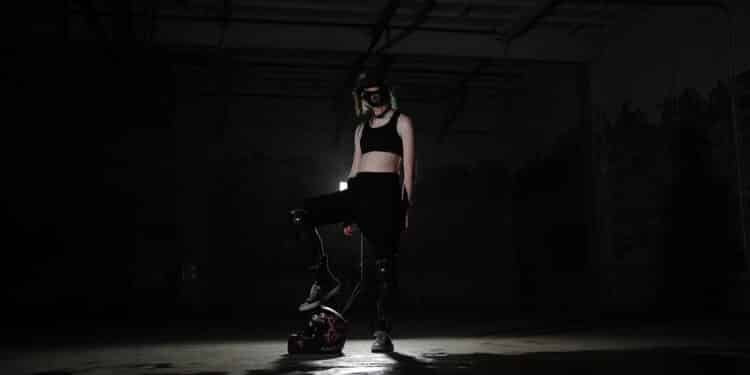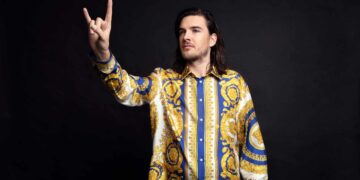Ariel Iasevoli, the resident aerialist at SILO, shares her journey, the challenges of her fused spine, and the magic of performing in the vibrant nightlife scene.
When I first saw Ariel Iasevoli, also known as Arielist, performing at SILO in Brooklyn, it was a complete surprise. Since when would an Anjuna lineup in a modestly sized nightclub have aerial performers? I soon learned that this wasn’t a one-off and that Ariel was a resident performer at the club. No matter the music each night, she dutifully and gleefully performs her act for all different crowds.
The next thing I learned about Ariel was how intriguing it would be to speak with her. Before we met for the interview, she sent me some material, including the amazing quote, “I was named after a Shakespearean Sprite and became a cyborg when I was 14. So perhaps my future was pre-determined.” So much of our discussion would follow this thread, and I only got more interested by the minute.
SILO has quickly become one of our favorite spaces in a very crowded part of Brooklyn, and having Arielist performing regularly is just one reason why. Ariel is one of many pieces integral to SILO’s success, but aside from being an important piece of the puzzle, she’s simply an incredible performer and an even more incredible human.
Ariel always has a beaming smile, and it’s clear that she absolutely loves her life. It isn’t just her love for life displayed every night; it’s her love for the audience. It seems obvious that doing her routine is one thing, but doing it for an audience that loves to watch—that’s the real magic. Check out one of her recent performances below and read on for our full conversation with her!
Hey Ariel, thanks for chatting with us today! How did you become an aerialist? Were flow and body arts part of your upbringing?
It all started with pole dancing. Actually, it all started when my parents named me Ariel. [Laughs] I guess it was my destiny! But it really started when I was 14 and was diagnosed with scoliosis and encouraged to get this crazy invasive surgery to correct it. I didn’t have any pain, but they were telling me that if we didn’t correct it early, it would be a huge problem as an adult. So I got this crazy surgery, and my spine is almost all metal and fused now. After that, I became in touch with bodies, pain, and mobility. I spent a lot of time working with people needing pain management and mobility.
Then, when I was 16 or 18, I started go-go dancing in bars, and one of them had a pole. I thought if I could learn how to climb the pole, I’d get more tips. I started taking pole dancing classes and I was truly addicted to it. I took classes almost daily and put up a pole in my home. Then, I wanted to perform more, but the only way to do that was to enter competitions, so that’s what I did. But those weren’t really for me; I was in it for the performance, not the competition.
I started to take aerial classes next, and that’s when I met Alex. He’s my universe partner, and he’s the SILO owner. At the time, he was running these events out of his basement in Bushwick and found a really small commercial space. He immediately put in a rigging plate and said I could perform at the parties. It was mostly seated circus shows at the time. He put so much trust in me that I was motivated to learn and achieve peak performances. That was about seven years ago and truly when it all came together.
How do you handle having a fused spine on an ongoing basis?
When your back is fused, your body compensates, and your hips actually get much more flexible. So this is helpful, but I can’t do all the traditional movements and positions the way they are designed. Instead, I have to work out the lines and tricks on my own and get them to look how I want them to look.
For example, I’ll see a move that looks really back-bendy, and I have to figure out how to do it, mostly with my hips and shoulders. I’m sort of cheating, I guess. The surgery and cyborg thing came out of nowhere. I didn’t have any pain issues, but then I was told to get my back checked out. And suddenly I had this problem that I didn’t want to have. It made me feel very alienated from my body because this thing had been here the whole time!
But afterward, I learned how resilient the body can be and how it can bounce back and learn all these new things. Sitting was one of the worst things; I needed to learn how to sit all over again. That really gave me a desire to help other people feel more connected to their bodies. Let’s all understand that we can listen to our bodies and often respond to what they tell us without doctors or medical treatment.
One nice thing is that I only learned pole and aerial movements after the surgery, so at least I’m not longing for tricks I could do before. My entire frame of reference is around the movements I do now, so that’s really nice.

Everything about the SILO experience seems very intentional (and that is why we love it so much)! Were you involved in pre-opening? How important are visual arts to the creators at SILO?
When Alex was looking for what is now SILO, he was looking for a bigger space. A big part of this was the desire to grow out of the more seated and curated events into more of a broader event space. When he found this space, he recognized how big a project he was taking on since it required a complete build-out. Once we put up the truss that holds everything, including aerial gear, we realized we could do much more with this space. So music took on a bigger role from the start while all the arts surrounding it were still very important.
This space just screamed for a more immersive experience. Music, 360-degree visuals, dancers, and aerial acts all fit together, and people seem to feel held by the space. We knew we needed to let the music and the DJs drive the aesthetic, and then we layered on top of that with the rest of the performance. It’s also cool to me that the aerialist is in the background behind the DJ. So, I’m not taking attention away from the DJ; I’m enhancing their art.
You previously told me that a big part of SILO’s inspiration is Anima Mundi, which is based on the idea that there is an intrinsic connection between all living beings. How do you put this inspiration into practice?
I see my role as casting a spell or doing a ritual, which is almost shamanistic. There’s light, sound, and even snacks as part of the complete experience. I do see myself as a tree spirit, and my role is to feed the fire that is already burning. It’s almost like the DJ is the magician, and everyone else is a minion to the magician.

Being a resident performer at SILO, you must know the area well, and this is an area known for its density of nightlife activities. What’s one hidden gem in the area that you’d like others to know about?
We get a lot of things from Western Beef nearby, and they have some of the most interesting, random items. Alex once discovered a bottle of White Hennessey on a dusty shelf. That is an item of legends! People sometimes argue over whether it even exists. So that’s a great neighborhood store to explore.
As we wrap up, what one thing would you like a first-timer coming to SILO to understand before they get there?
There’s something for everyone here! If you are a sound purist, we have two enormous Danley subwoofers as part of a great sound system, and you can stand right next to them. Alex has a PhD in Electrical Engineering, so he took the setup very seriously.
If you are here to dance, we have a great dancefloor with the DJ in the middle instead of separated. We have a great front area where you can chill, and we’ve been projecting movies on the back wall. So if you need to escape, you can chill there and watch the movie. There are immersive visuals in the main room and occasional aerial activations above the stage. You can dance on stage at any time, even during performances. Stick around past 2:30, and you’ll get a complimentary Capri Sun!








